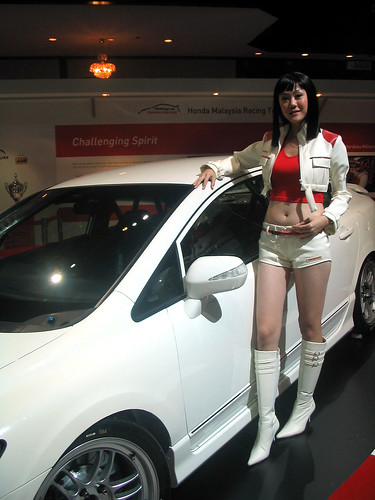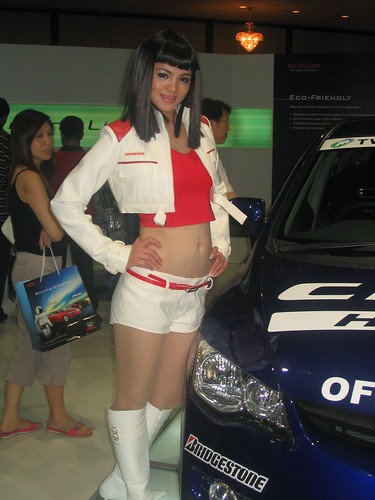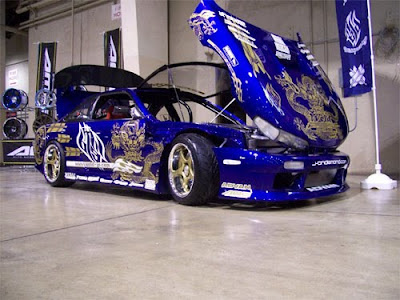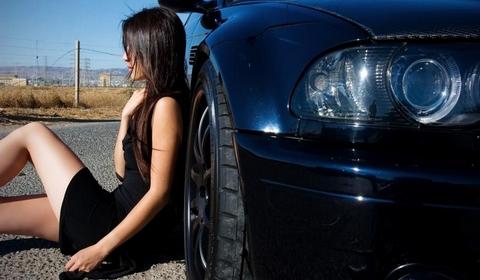Monday, February 28, 2011
Design McLaren MP4-12C
Carrera Facelift Porsche 911 Sports Car.
Ferrari 458 Italia Spider
AF-10 Arash Sports Car
Canadian HTT Pléthore LC-750 Sports Car
Audi Sports Car RS5
Sunday, February 27, 2011
2010 Chevrolet Camaro Hamann
 2010 Chevrolet Camaro Hamann Picture
2010 Chevrolet Camaro Hamann PictureSaturday, February 26, 2011
2011 Nissan Electric Sports Cars ESFLOW Concept







Dodge Challenger All Models
A 1970-only model was the Dodge Challenger T/A (Trans Am) racing homologation car. In order to race in the Sports Car Club of America's Trans American Sedan Championship Trans Am, Dodge built a street version of its race car (just like Plymouth with its Plymouth 'Cuda AAR) which it called the Dodge Challenger T/A (Trans Am). Although the race cars ran a destroked version of the 340, street versions took the 340 and added a trio of two-barrel carburetors atop an Edelbrock aluminum intake manifold, creating the 340 Six Pack. Dodge rated the 340 Six Pack at 290 bhp (216.3 kW), only 15 bhp (11 kW) more than the original 340 engine (which also had the same rating as the Camaro Z/28 and Ford Boss 302 Mustang). The engine actually made about 320 bhp (238.6 kW). It breathed air through a suitcase sized air scoop molded into the pinned down, hinged matte-black fiberglass hood. Low-restriction dual exhausts ran to the stock muffler location, then reversed direction to exit in chrome tipped "megaphone" outlets in front of the rear wheels. Options included a TorqueFlite automatic or pistol-grip Hurst-shifted four-speed transmission, 3.55:1 or 3.90:1 gears, as well as manual or power steering. Front disc brakes were standard. The special Rallye suspension used heavy duty parts and increased the rate of the rear springs. The T/A was the first U.S. muscle car to fit different size tires front and rear to give a racing stance: E60x15 in the front, and G60x15 in the rear. The modified chamber elevated the tail enough to clear the rear rubber and its side exhaust outlets. Thick dual side stripes, bold ID graphics, a fiberglass ducktail rear spoiler, and a fiberglass front spoiler added to the racing image. The interior was strictly stock Challenger.
Dodge contracted Ray Caldwell's Autodynamics firm in Marblehead, Massachusetts to run the factory Trans-Am team. Sam Posey drove the #77 "sub-lime" painted car that Caldwell's team built from a car taken off a local dealer's showroom floor. When the #76 was completed mid-season from a chassis provided by Dan Gurney's All American Racers, Posey alternated between the two. Both cars ran the final two races, with Posey in the #77. Ronnie Bucknum drove the #76 at Seattle Washington, and Tony Adamowicz drove it at Riverside, California.
The Challenger T/A's scored a few top three finishes, but lack of a development budget and the short-lived Keith Black 303 c. i. engines led to Dodge leaving the series at season's end. .
The street version suffered from severe understeer in fast corners, largely due to the smaller front tires. Only 2,399 T/As were made. A 1971 model using the 340 engine with a 4-barrel carburetor was planned and appeared in advertising, but was not produced since Dodge had left the race series.
The "Western Special" was a version available only to west coast dealers. It came with a rear-exit exhaust system and Western Special identification on the rear decklid. Some examples came with a vacuum-operated trunk release. Another late production version was the low-priced "Deputy", stripped of some of the base car's trim and with fixed rear side glass.
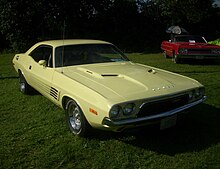
By 1972, the convertible version and all the big-block engine options were gone. Maximum power was also downgraded to 240 horsepower (180 kW) to reflect the more accurate Society of Automotive Engineers (SAE) net hp calculations. The 1972 models also received a new grille that extended beneath the front bumper. The only 1972 convertibles which exist are actually 1971 models with the 1972 front end (grille, lights, etc.) and rear end (tail lights and their panel). These were specially built for TV programs such as "Mod Squad". The only way to ascertain a 'real' 1972 Challenger convertible is to look at its fender tag. On the code line which gives the dealer order number, that number will start with an "R", which designates "Special Meaning" (in this case, a TV 'special promotions' car).
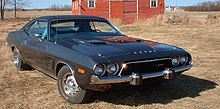

The 1973 models were no longer available with a six-cylinder engine. For 1974, the 340 cu in (5.6 L) engine was replaced by a 360 cu in (5.9 L) version, but the pony car market had deteriorated and production of Challengers ceased in mid-1974.
[edit] Cosmetic variations
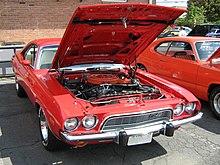

Although the body style remained the same throughout the Challenger's five year run, there were two notable changes to the front grille. The 1971 models had a "split" grille, while 1972 introduced a design that extended the grille (nicknamed the "sad-mouth") beneath the front bumper. With this change to the front end, 1972 through 1974 models had little to no variation. The only way to properly distinguish them is that the 1972s had flush mounted bumpers with no bumper guards, (small bumper guards were optional), while both the 1973 and 1974 models had the protruding "5 mph (8.0 km/h)" bumpers (with a rubber type filler behind them) in conjunction with large bumper guards. The 1974 cars had larger rear bumper guards to meet the (new for 1974 and on) rear 5 mph rear impact law. These changes were made to meet U.S. regulations regarding crash test safety.
The 1970 taillights went all the way across the back of the car, with the backup light in the middle of the rear. In 1971, the backup lights were on the left and right instead of the middle. The taillight array also changed for 1972 onwards, with the Challenger now having four individual rectangular lamps.
[edit] Collectibility
Although few mourned the end of the E-body models, the passage of time has created legends and highlighted the unique personalities of both the Challenger and the Barracuda.[2] In a historic review, the editors of Edmunds Inside Line ranked these models as: 1970 was a "great" year, 1971 was a "good" one, and then "three progressively lousier ones" (1972–1974).[2] With total sales and production off by 2/3rds from 1970, the performance engine 1971 Challengers are the most rare. Sales and production of the 1973 cars (with only two V8s available) actually exceeded 1971 by approximately 1,000 cars. This may be explained by 1973 being a very good year for the U.S. auto industry in general and an increased interest in Chrysler (the Plymouth Barracuda and Plymouth Road Runner also saw sales increases) performance cars.
Original "numbers matching" high-performance 1970-71 Challengers are now among the most sought-after collector cars.[citation needed] The rarity of specific models with big engines is the result of low buyer interest and sales with the correspondingly low production when new. The 440 and the 426 Hemi engines nowadays command sizable premiums over the smaller engines.The 1970 and 1971 models tend to generate more attention as performance and style options were still available to the public. However, with the popularity of these vehicles increasing, and the number of usable and restorable Challengers falling, many collectors now search for later models. Many "clones" of the 1970 and 1971 Challengers with high-performance drivetrains have been created by using low-end 6-cylinder and 318-powered non-R/T or T/A cars and installing one of the "Magnum" performance engine combinations (340, 383, 440 or 426 Hemi) and adding the specific badging and hoods. Total production (1970–74) was only about 168,000 cars, and perhaps 1/3 of that number now exist in any condition.
 Dodge Challenger
Dodge Challenger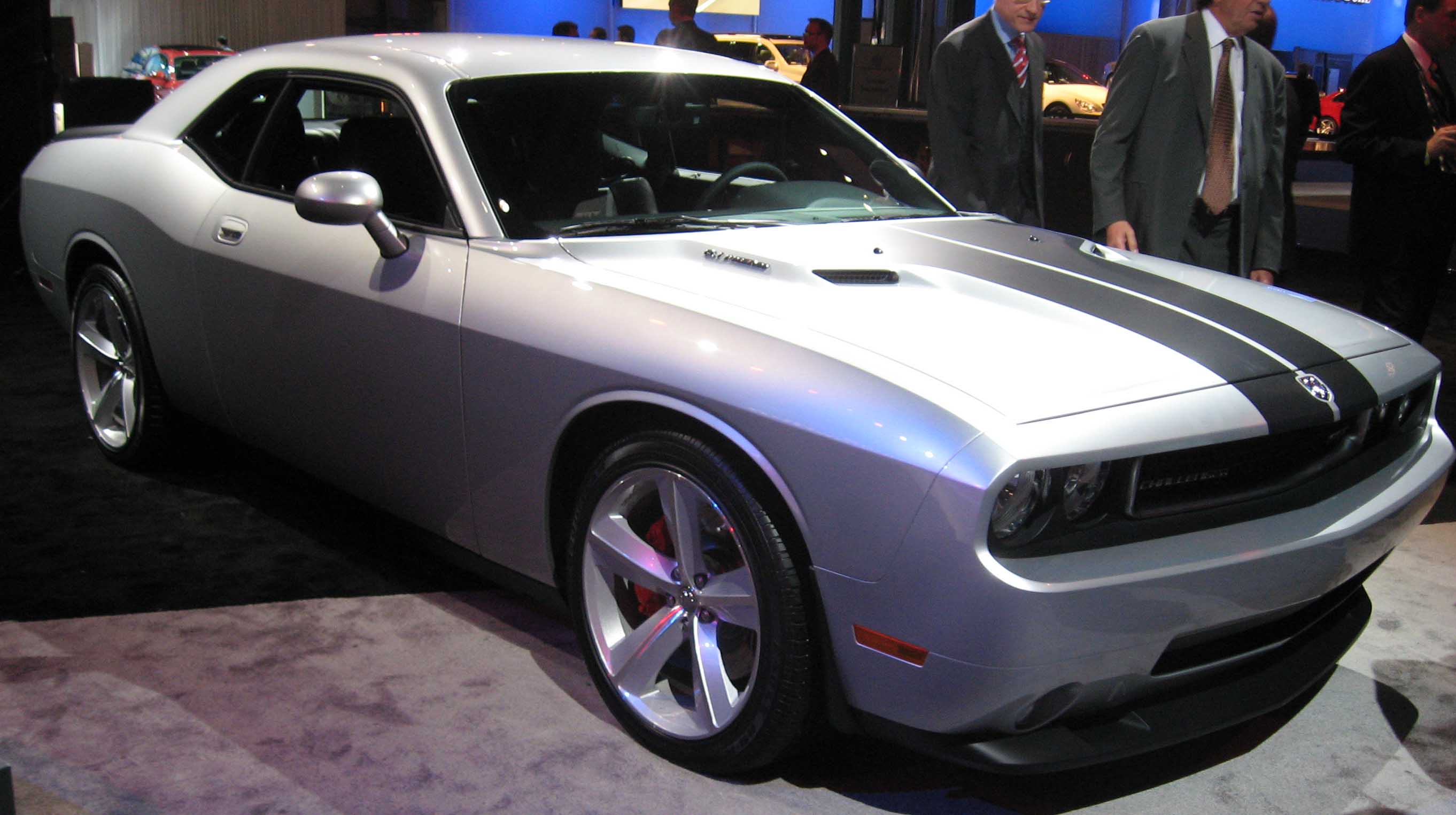 Dodge Challenger
Dodge Challenger Dodge Challenger
Dodge Challenger Dodge Challenger
Dodge Challenger Dodge Challenger
Dodge Challenger Dodge Challenger
Dodge Challenger Dodge Challenger
Dodge Challenger Dodge Challenger
Dodge Challenger Dodge Challenger
Dodge Challenger Dodge Challenger
Dodge Challenger

